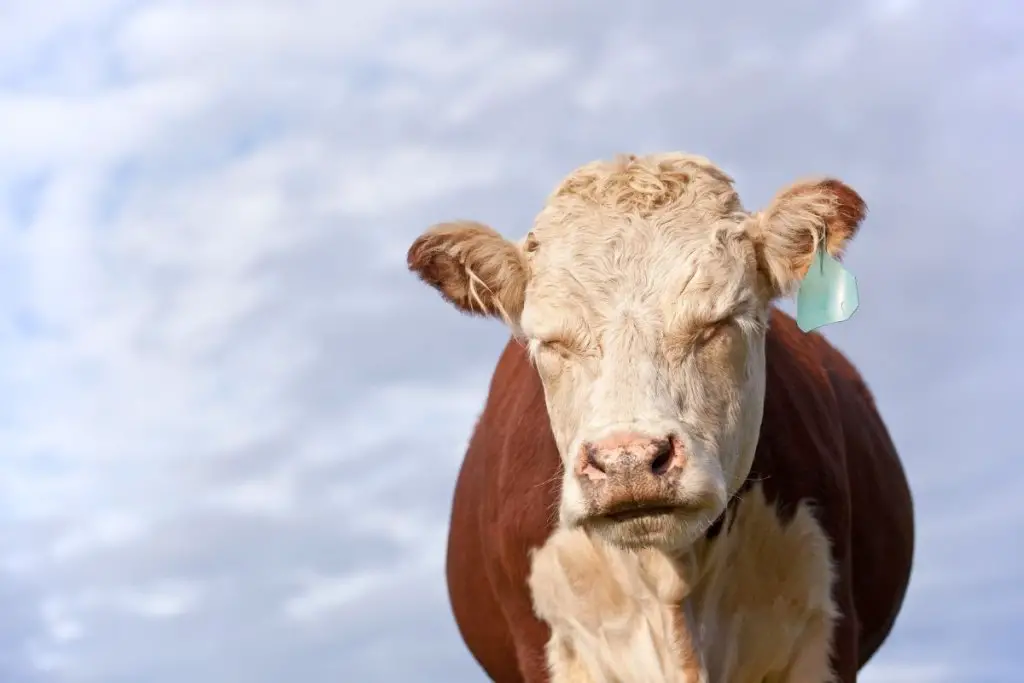Cows do sleep while standing up, and will sleep around 4 hours in any 24 hour period. They only sleep standing while dozing or sleeping lightly and will choose to lay down for a deep sleep.
Most large herbivores, such as horses, moose, giraffes, bison, rhinos, and zebras, mirror this behavior. In fact, elephants sleep standing up most of the time!
Amy Johnson of the University of Pennsylvania School of Veterinary Medicine explains that these animals feature a “stay apparatus.” Their legs have ligaments and tendons that lock in place with little or no muscular effort, allowing them to stand up even while asleep.
These genetic modifications are due to them being prey animals. It’s a genetic throwback to when they lived in the wild and had to be constantly ready to flee from predators. Large herbivores are not particularly fast runners, so any reaction times before escape must be as short as possible.
Table of Contents
How Do Cows Sleep?
Cows tend to group together in a herd and often near trees when they sleep. This behavior is another genetic throwback to habits learned while they were still wild and banded together for protection from predators.

During their periods of deeper slumber – usually around a couple of hours – the cow is completely prone. You will sometimes find them on their sides if they feel totally at ease or, more commonly, with the middle of the belly on the ground and their legs tucked underneath them. The head is bowed or resting on the ground, and the eyes are closed.
Amy Johnson adds that when horses sleep standing up, they are in a state of slow-wave sleep, which is not as deep as REM sleep.
Benefits of Sleep in Cattle
Sleep is beneficial to cattle in several ways.
The prone position means the udder is resting on the ground and not hanging taut as it would normally. This allows more unrestricted blood circulation around their udders and helping with milk production.
Hooves also can relax from the considerable weight they support while the cow is on its feet, and any excess moisture they might have gathered has a chance to dry off.
Although cows can snooze while standing up, they can’t go into REM sleep, which they need to prevent sleep deprivation. Sleep-deprived dairy cows produce less milk and are more challenging to manage.
Typical Cow Sleep Durations
Yet another legacy of evolution is that cows only need 4 hours of sleep daily. As prey animals, they feel the need to be awake as much as possible to be prepared for threats.
Most cows only enter REM sleep for about 1 to 2 hours. Much like us, cows like to nap and often spread their sleeping time into daily intervals. It is quite common to find them wide awake and standing up in the middle of the night.
Do Cows Sleep with Eyes Open or Closed?
Cows sleep with their eyes closed.

They have eyelids to protect their eyes from insects, debris, and other harmful elements while asleep. While they are dozing standing up, they can also have their eyes closed.
Cow Tipping
The concept of cow tipping involves sneaking up on a standing cow and pushing it over in one go. The general misconception is that cows struggle to right themselves when knocked over or lying down, which, as stated above, is untrue. This belief dates to the Roman Empire, although it wasn’t until the 1970s that cow tipping gained popularity.
As we have already read, cows still bear genetic traits of prey animals formed long ago, are exceedingly difficult to surprise, and will certainly not stand still if approached by a stranger. Add to that the massive weight of an adult, and you would be hard-pressed to lay a hand on one, let alone send it sprawling.
Facts-and-figures-wise, a fully-grown cow weighs about 1,000 pounds, and a bull commonly weighs around 1,800 pounds. A person that weighs about 150 pounds can generate about 650 Newtons of force. A 1,500-pound cow would need over 1,300 Newtons of energy to tip over, i.e., two people minimum.
Even if a cow stood still, it would brace as soon as it felt contact or even sensed the presence of an intruder, and a four-legged platform is highly stable. Conservative estimates suggest it may take 10 or more people to push a cow over that is tensing its muscles and instinctively leaning into the force applied.
Cow Bedding
Aim to provide a firm and comfortable base for your cows to lie on if they spend time inside their barn. The material should support the whole body and “give” a little but not too much, as cattle hooves need support to walk on.
Paper, compost, straw, or sawdust are commonly used materials. If you use sand, ensure it is not too abrasive and doesn’t scratch the animals’ skin. The surface must stay dry and clean to prevent the presence of disease-carrying microbes.
Some farmers use compost bedded packs for their cattle to sleep. Compost is spread onto a sizeable accessible area filled with sawdust or wood shavings, mixed, and then turned regularly.
